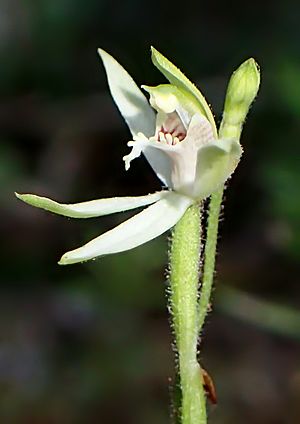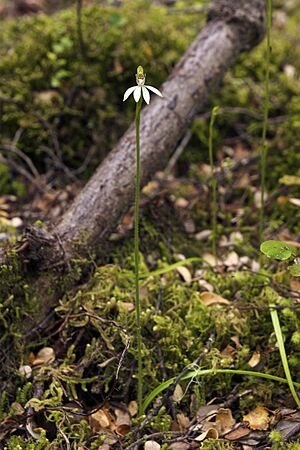Caladenia chlorostyla facts for kids
Quick facts for kids Caladenia chlorostyla |
|
|---|---|
 |
|
| C. chlorostyla near Havelock, New Zealand | |
| Scientific classification | |
| Genus: |
Caladenia
|
| Species: |
chlorostyla
|
| Synonyms | |
|
|
Caladenia chlorostyla is a special plant from the Orchid family. It grows only in New Zealand, meaning it is endemic there. This ground orchid has a single, narrow leaf that is a bit hairy. It usually grows one flower that can be pale purple, pink, or white.
Contents
What Does Caladenia chlorostyla Look Like?
C. chlorostyla is a plant that grows from the ground. It is a perennial, which means it lives for more than two years. It is also a deciduous herb, meaning it loses its leaves each year and does not have a woody stem. This plant usually grows by itself.
It has a special underground part called a tuber, which stores food. The plant also has one bright green leaf. This leaf is narrow and can be up to 15 cm (6 in) long and 3 mm (0.1 in) wide.

The plant usually has one flower, but sometimes up to five. These flowers do not have a smell. Each flower is about 11 to 16 mm (0.4 to 0.6 in) wide. They grow on a thin, strong stem that can be up to 30 cm (12 in) tall.
The flower parts called sepals and petals are white, pale purple, or pink. Their tips are often greenish-white. The top sepal stands straight up. The side sepals are flat and spread out. The petals can spread wide or turn inwards.
The top sepal is about 6 to 11 mm (0.2 to 0.4 in) long and shaped like a narrow egg. The side sepals and petals are about 6 to 8 mm (0.2 to 0.3 in) long. They are curved like a sickle.
The column of the flower, which is a special part in the middle, is green with red stripes. These orchids bloom between September and January. After flowering, they produce a green, oval-shaped fruit. This fruit is called a capsule and is about 10 to 12 mm (0.4 to 0.5 in) long. Sometimes, it has purple stripes.
How Was Caladenia chlorostyla Named?
Scientists officially described C. chlorostyla for the first time in 1997. David Jones, Brian Molloy, and Mark Clements named it. They found a sample of the plant near the Tinline River. Their description was published in a special magazine called The Orchadian.
Where Does Caladenia chlorostyla Grow?
This type of orchid likes sunny places. It grows in areas with scrub, which are low bushes and small trees. You can also find it in old forests. Interestingly, it often grows in older pine tree farms too.
Another plant, C. saccata, is actually the same species as C. chlorostyla in New Zealand. This means they are considered the same plant by scientists.
Is Caladenia chlorostyla Endangered?
In 2012, experts checked on C. chlorostyla. They decided that this plant is "not threatened." This means there are enough of them, and they are not in danger of disappearing.

